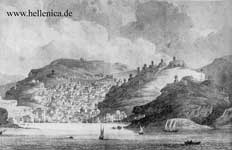.
Administrative Region : Attica
Regional unit : Islands
Hydra (Greek: Ύδρα, pronounced [ˈiðra] in modern Greek) is one of the Saronic Islands of Greece, located in the Aegean Sea between the Saronic Gulf and the Argolic Gulf. It is separated from the Peloponnese by narrow strip of water. In ancient times, the island was known as Hydrea (Υδρέα, derived from the Greek word for "water"), which was a reference to the springs on the island.

The municipality Hydra consists of the islands Hydra (area 50 km2), Dokos (pop. 13, area 12.5 km2) and a few uninhabited islets.
There is one main town, known simply as "Hydra port" (pop. 2,526 in 2001). It consists of a crescent-shaped harbor, around which is centered a strand of restaurants, shops, markets, and galleries that cater to tourists and locals (Hydriots). Steep stone streets lead up and outwards from the harbor area. Most of the local residences, as well as the hostelries on the island are located on these streets. Other small villages or hamlets on the island include Mandraki (pop. 33), Kamini, Vlychos (28), Palamidas (18), Episkopi, and Molos (2).
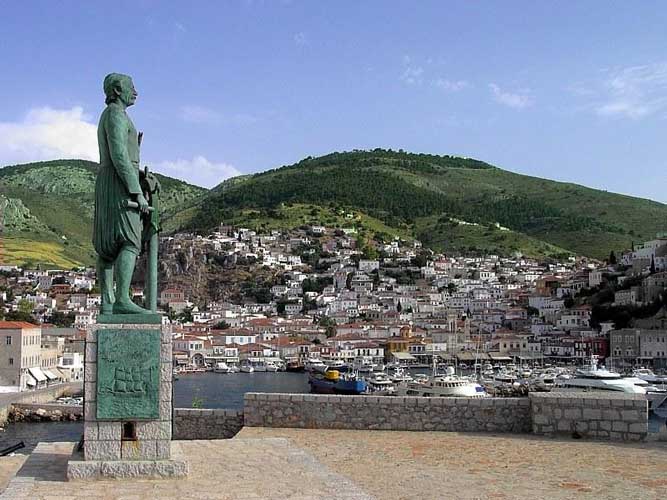
Statue in Hydra commemorating Andreas Miaoulis.
Transport, tourism and leisure
No cars are allowed in Hydra, so the only transport is by donkey, bicycle or foot.Hydra depends upon tourism, and Athenians comprise a sizeable segment of its visitors. High speed hydrofoils and catamarans from Piraeus, some 37 nautical miles (69 km) away, serve Hydra, as do daily island ferry boats. (The ferries take about three hours for the transit; the hydrofoils and catamarans substantially less.) The island also has ferries to Aegina, Poros, Spetses, Nafplion and Monemvasia.
Garbage trucks are the only motor vehicles on the island, as cars or motorcycles are not allowed by law. Donkeys, bicycles, and water taxis provide public transportation. The inhabited area, however, is so compact that most people walk everywhere.
Hydra benefits from numerous bays and natural harbours, and has a strong maritime culture. The island remains a popular yachting destination, and is the home of the Kamini Yacht Club, an international yacht club based in the port of Kamini.
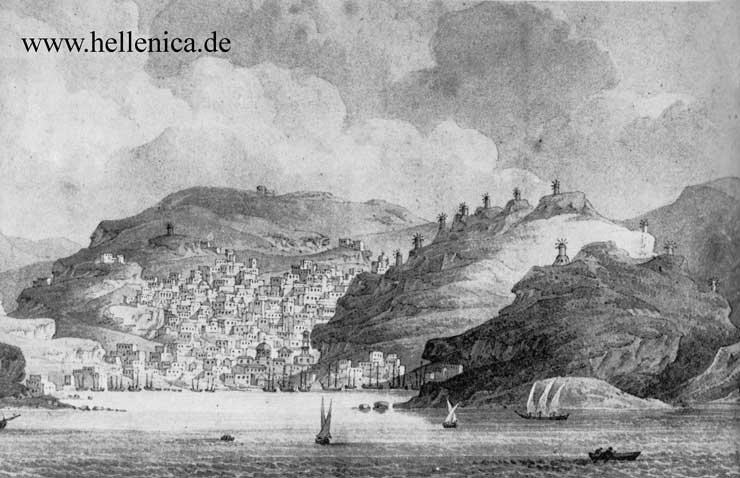
Hydra 1795
Captains' mansions
The Tsamadou mansion on the left-hand side of the harbour as one enters is now a Maritime Academy.
The Tombazi mansion is now part of the School of Fine Arts.
The mansions of Lazarus and George Kountouriotis, Boudouri, Kriezi, Voulgari, and Miaouli all contain collections of 18th Century island furniture. The descendants of Lazarus Kountouriotis donated his mansion to the Historic-Ethnologic Institute of Greece. Today, it operates as extension branch of the National Museum of History.
Monasteries and the Cathedral
There are numerous churches and six Orthodox monasteries. Two particularly noteworthy monasteries are Profitis Ilias, founded in the 19th Century, and Ayia Efpraxia. Both are on a hill overlooking the main harbour.
The island's Cathedral is the old Monastery of the Dormition of the Virgin and sits on the quayside in the town. The Monastery contains the tomb of Lazarus Koundouriotis, the richest sea captain on Hydra, who gave his entire fortune to support the Greek War of Independence.
History
Pre-history, antiquity, and the Byzantine Era
A snapshot from Hydra's seafront.
View of the port.

Hydra, 1880, Photo: Petros Moraitis
Hydra has never been linked to any Greek legend, god, hero, or mythological event.
There is evidence of farmers and herders from the second half of the third millennium BCE, on the small flat areas that are not visible from the sea. Obsidian from Milos has also been found. During the Helladic period, Hydra probably served as a maritime base for the kingdoms on the Greek peninsula. Fragments of vases, tools, and the head of an idol have been found on Mount Chorissa.
The large-scale Dorian invasion of Greece around the 12th Century BCE appears to have resulted in a depopulation of the island. Hydra was repopulated by farmers and herders, perhaps sailing from the mainland port of Ermioni, in the 8th Century BCE. Herodotus reports that towards the 6th Century BCE, the island belonged to Ermioni, which sold it to Samos. Samos, in turn, ceded it to Tizina.
For much of the past, Hydra has stayed on the margins of history. The population was very small in ancient times, and except for the brief mentions in Herodotus and Pausanias, has left little or no record in the history of those times.
It is clear that Hydra was populated during the Byzantine Era, as vases and coins have been discovered in the area of Episkopi. However, it appears that the island again lost its population during the Latin Empire of Constantinople as the inhabitants fled the pirate depredations. On other islands, inhabitants moved inland, something that was essentially impossible on Hydra.
Between 1204-1566 it belonged to Venice. From 1566 to 1821 (nominally 1829), it was part of the Ottoman Empire.
In the sixteenth century, the island began to be settled by refugees, Greek and Albanian, due to the warfare between the Ottomans and Venetians.[1] The Arvanites' presence was evident until the mid-20th century, when according to T. Jochalas the majority of the island's population was composed of Arvanites.[2] The island is known in Arvanitika as Nίδρα.[2]
The period of commercial and naval strength
Hydra was relatively unimportant during much of the period of Ottoman rule. Its naval and commercial development began in the 17th Century, and its first school for mariners was established in 1645.[3] Apparently, the first truly Hydriot vessel was launched in 1657. However, the conflict between the Republic of Venice and the Ottoman Empire limited the island's maritime development until after 1718 and the Treaty of Passarowitz. From the 17th Century on, Hydra began to take on a greater importance due to its trading strength.
During the first half of the 18th Century, Hydra built the same kind of vessels as were built in the other Aegean Islands. These were the sachtouri of 15 to 20 tons, and the latinadiko of 40 to 50 tons. The Hydriots contented themselves with trading in the Aegean, going as far as Constantinople. The great change occurred in 1757 after they launched a vessel of 250 tons. The larger boats enabled Hydra to become an important commercial port. By 1771, one could count up to 50 vessels from throughout Greece in the roads. Ten years later the island had fitted out 100 vessels.[4]
However, the Ottoman Empire and its policies constrained Hydra's economic success. Heavy tariffs and taxes limited the speed of development. The Ottoman administration limited free trade; the Ottomans permitted only Ottoman vessels to navigate the Dardanelles and the Bosphorus, and hence have access to the Black Sea, its ports, and the trade in grain from their hinterlands. The Treaty of Küçük Kaynarca changed all this. Russia gained from the Ottoman Empire the right to protect the Empire's Orthodox Christians. The religious protection had a commercial corollary: the Hydriots began to sail under the Russian flag. The Treaty also provided for free passage between the Aegean and the Black Sea. Hydra entered its commercial era. Hydriot vessels carried goods between Southern Russia in the east to the Italian ports of Ancona and Livorno in the west. From 1785 on, the Hydriote shippers began to engage in commerce, not just transport. Each vessel became its own small commercial enterprise and quickly trade with the Levant began to depend on Hydra's vessels, though not without competition from those of Spetses and Psara.
However, the plague of 1792 killed a large part of the population, and many people moved away. As a result the town was almost completely abandoned for a while. Still, by the end of the 18th century Hydra had again become quite prosperous as its vessels trading as far as France, Spain and even the Americas. Napoleon presented the island with the huge silver chandelier in the cathedral as a gesture of gratitude for the Hydriots' role in running the British blockade and so bringing food to France and Europe.
The Greek War of Independence and the decline
Flag of Hydra during the Greek War of Independence.
Statue of Andreas Miaoulis, Greek admiral during the Greek War of Independence (1821-1830).
Cannon at Hydra.
In the 19th Century, Hydra was home to some 125 boats and 10,000 sailors. The mansions of the sea captains that ring the harbor are a testament to the prosperity that shipping brought to the island which, at the date of the Revolution, had 16,000 inhabitants. During the Greek Revolution, the fleets of Hydra and the other two naval islands of Psara and Spetses were able to wrest control of the Eastern Aegean Sea from the Ottoman Empire.
When the Greek War of Independence broke out, Hydra's contribution of some 150 ships, plus supplies, to fight against the Turks played a critical role. The Greek admiral Andreas Miaoulis, himself a settler on Hydra, used Hydriot fire ships to inflict heavy losses on the Ottoman fleet.
With the end of the revolution and the creation of the Greek state, the island gradually lost its maritime position in the Eastern Mediterranean, igniting an economic crisis which led to a period of hardship and unemployment. The main reason was that with the creation of the Greek state, its fleet lost the privileges which the Treaty of Küçük Kaynarca and the use of the Russian flag gave it. Another reason was that the traditional families who owned the majority of the fleet failed to foresee the benefits in participating in the steam ship revolution that significantly cut shipping operational costs through reduced crew and independence of the winds, putting them at a disadvantage vis-á-vis the new shipping companies of Piraeus, Patras and Syros. A third reason was that the new conditions made illegal activities such as piracy impossible. Once again many of the inhabitants abandoned Hydra, leaving behind their large mansions and beautiful residences, which fell into ruin. The mainstay of the island's economy became fishing for sponge. This brought prosperity again, at least until 1932 when Egypt forbade fishing along its coast. By the Second World War the Hydriotes were again leaving the island, many of whom went abroad.
Second World War
Between 1941 and 1943, during the Axis occupation of Greece during World War II, there was famine on Hydra. It is estimated that some eight percent of the population died of starvation.
Historical population
Year Town population Municipality/Island population
1981 2,732 -
1991 2,279 2,387
2001 2,526 2,719
Topography and ecology
View from the promenade.
Street of the island.
The dominant geographic features of Hydra are its rocky hillsides, which are bare, pine forested valleys with the occasional farmhouse. The island was subject to a modern geologic study by Renz in 1955. Some of the later Permian limestone strata are rich in well-preserved fossils.
There are many types of wild flowers including rare 'spentzes' or cyclamen and poppies. As well as pine trees there are cypress and olive trees. Birds species include partridges, quails, and many migratory birds which are subject to local hunting. Mammals include rabbits, feral cats and goats. There are also said to be some reptiles and amphibians.
Although the island's name is derived from ancient springs known to the Ancient Greeks, it is now almost dry. Hydra previously had wells, and three new wells have been found. Today, the island imports its water by boat from the Greek mainland, but a new desalinization plant is now finished but not in operation. Many local people store winter rainfall in cisterns beneath their houses, to be used later as drinking water.
A savage fire during the intense heat of 2007 destroyed much of the pine forest to the east of Hydra port. However, the fire left untouched some forest above Kamini and at the west end of Hydra. The forest around Molos, Bisti, and Agios Nikolaous were also unaffected.
The island has almost no night-time light pollution. This is a boon to astronomy.
Cultural life
The Hydrama Theater and Arts Center hosts performances, drama and dance workshops for the local community and courses in ancient Greek theater for international participants.
The island hosts an annual conference on Rebetiko, a type of Greek urban folk music, that is held in mid-October.
In June 2009 the important art collector Dakis Joannou opened a Hydra branch of private art museum, the Deste Foundation. It intends to show the work of already established young artists.
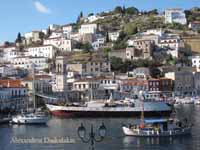

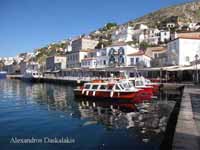
Notable people
Andreas Miaoulis (1768–1835) admiral and politician
Laskarina Bouboulina (1771–1825) heroine of the Greek War of Independence
Iakovos Tombazis (1782–1829) merchant, ship-owner and admiral
Georgios Kountouriotis (1789–1858) politician, Prime Minister of Greece
Lazaros Kountouriotis gave up his fortune to arm a Greek navy during the Greek War of Independence.
Antonios Kriezis (1796–1865) revolutionary fighter and one of the first Greek Prime Ministers
Dimitrios Voulgaris (1802–1878) revolutionary fighter, Prime Minister of Greece
Athanasios Miaoulis (1815–1867) Prime Minister of Greece
Nikolaos Vokos (1854–1902) painter
Pavlos Kountouriotis (1855–1935) naval hero, admiral and President of Greece
Nikolaos Votsis (1877–1931) naval hero and admiral
Dorotheus (1888–1957) Archbishop of Athens and All Greece
Nikos Nikolaou (1909–1986) artist
Gikas N. Koulouras Shipowner, member of Parliament, philanthropist, founder and first President of the Greek Shipowners Association
Panayiotis Tetsis (1925) painter
Leonard Cohen (1934) Canadian poet and song-writer
Michalis Maniatis (1952) film and TV actor, producer, screen and book writer
Rallou Manou, choreographer
Emmanuel Tombazis
Elena Votsi (b. 1964), jewellery designer
Anastassios Tsamados, Captain of the Arès, who died in the Battle of Sphacteria (1825), holding off the Egyptian-Turkish landing force.
Dimitrios Voulgaris
Axel Jensen (1932–2003) Norwegian author
George Johnston (1912–1970) Australian journalist, novelist and writer
Charmian Clift (1923–1969) Australian novelist and writer
Göran Tunström (1937–2000) Swedish author
Books about or set on Hydra
The Colossus of Maroussi, Henry Miller (1941)
Rien ne va plus (The Sleepwalker), Margarita Karapanou (1994)
Clouds over Hydra, Charles Young (1996)
Fugitive Pieces, Anne Michaels (1996)
The Riders, Tim Winton (1996)
Hydra and the Bananas of Leonard Cohen, Roger Green (2003)
Rhubarbs from a Rock, David Fagan (2003)
Lighthousekeeping, Jeannette Winterson (2006)
Hydra, Catherine Vanderpool (1980)
Movies filmed on Hydra
Boy on dolphin, a statue based on the feature-film of the same name.
Girl in Black (Greece 1956)
Boy on a Dolphin (1957). Hydra was the setting for this Sophia Loren hit movie.
Phaedra (1962)
Island of Love (1963)
Incense for the Damned (1970)
Out of the Shadows (1988)
The Blue Villa (Un Bruit Qui Rend Fou) (1995)
Boat Trip (2002)
Fugitive Pieces (2007)
Municipality Hydra(Seat: Ύδρα, η) |
|---|
| Agios Ioannis (Άγιος Ιωάννης, ο (νησίδα)) |
| Agios Konstantinos (Άγιος Κωνσταντίνος, ο) |
| Άγιος Νικόλαος, ο (νησίδα) |
| Βένιζα, η (νησίδα) |
| Vlychos (Βλυχός, ο) |
| Dokos (Δοκός, η (νησίδα)) |
| Episkopi (Επισκοπή, η) |
| Zogeri (Ζώγερι, το) |
| Ζωγκαίϊκα, τα |
| Κιβωτός, η (νησίδα) |
| Κλιμάκι, το |
| Λιμιόνιζα, η (νησίδα) |
| Mandraki (Μανδράκι, το) |
| Μονή Αγίας Ευπραξίας, η |
| Μονή Αγίας Τριάδος, η |
| Μονή Αγίου Νικολάου, η |
| Μονή Γεννήσεως Θεοτόκου Ζούρβας, η |
| Μονή Προφήτου Ηλιού, η |
| Molos (Μώλος, ο) |
| Palamidas (Παλαμιδάς, ο) |
| Πέτασι, το (νησίδα) |
| Πλατονήσι, το (νησίδα) |
| Σταυρονήσι, το (νησίδα) |
| Τρίκερι, το (νησίδα) |
| Ύδρα, η |
References
^ Vanderpool, Catherine (1980) Hydra, Athens Lycabettus Press, pp. 3-4.
^ a b Jochalas, Titos P. (1971): Über die Einwanderung der Albaner in Griechenland: Eine zusammenfassene Betrachtung ["On the immigration of Albanians to Greece: A summary"]. München: Trofenik.
^ Iles grecques, Guide Bleu, Hachette, 1998. p. 185.
^ Georgios Voyatis, Le Golfe Saronique, p. 164.
Greece :
| Ancient Greece
Science, Technology , Medicine , Warfare, , Biographies , Life , Cities/Places/Maps , Arts , Literature , Philosophy ,Olympics, Mythology , History , Images Medieval Greece / Byzantine Empire Science, Technology, Arts, , Warfare , Literature, Biographies, Icons, History Modern Greece Cities, Islands, Regions, Fauna/Flora ,Biographies , History , Warfare, Science/Technology, Literature, Music , Arts , Film/Actors , Sport , Fashion --- |
Retrieved from "http://en.wikipedia.org/"
All text is available under the terms of the GNU Free Documentation License


